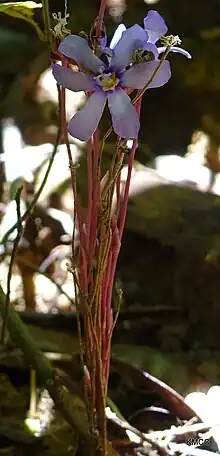Geosiris aphylla
Geosiris aphylla is a species in the flowering plant family Iridaceae, first described in 1894. It is endemic to Madagascar.[1]
| Geosiris aphylla | |
|---|---|
 | |
| Scientific classification | |
| Kingdom: | Plantae |
| Clade: | Tracheophytes |
| Clade: | Angiosperms |
| Clade: | Monocots |
| Order: | Asparagales |
| Family: | Iridaceae |
| Genus: | Geosiris |
| Species: | G. aphylla |
| Binomial name | |
| Geosiris aphylla | |
Geosiris aphylla is sometimes called the earth-iris. It is a small myco-heterotroph lacking chlorophyll and obtaining its nutrients from fungi in the soil.[2]
Description
Its rhizomes are slender and scaly, and stems are simple or branched. The leaves are alternate, but having no use, are reduced and scale-like (hence the epithet "aphylla," meaning "without leaves"). The flowers are light purple.
Range and habitat
Geosiris aphylla is native to central and eastern Madagascar. It lives in forest humus in humid lowland and montane forests, between 400 and 1200 meters elevation.[3]
References
- Kew World Checklist of Selected Plant Families
- Manning, John; Goldblatt, Peter (2008). The Iris Family: Natural History & Classification. Portland, Oregon: Timber Press. pp. 96–98. ISBN 978-0-88192-897-6.
- Jonker, F.P. (1939). "Les Géosiridacées, une nouvelle famille de Madagascar". Mededelingen van het Botanisch Museum en Herbarium van de Rijksuniversiteit te Utrecht, vol. 60 no. 1, pp. 473-479. 1 January 1939.
This article is issued from Wikipedia. The text is licensed under Creative Commons - Attribution - Sharealike. Additional terms may apply for the media files.